Page 18 of 468
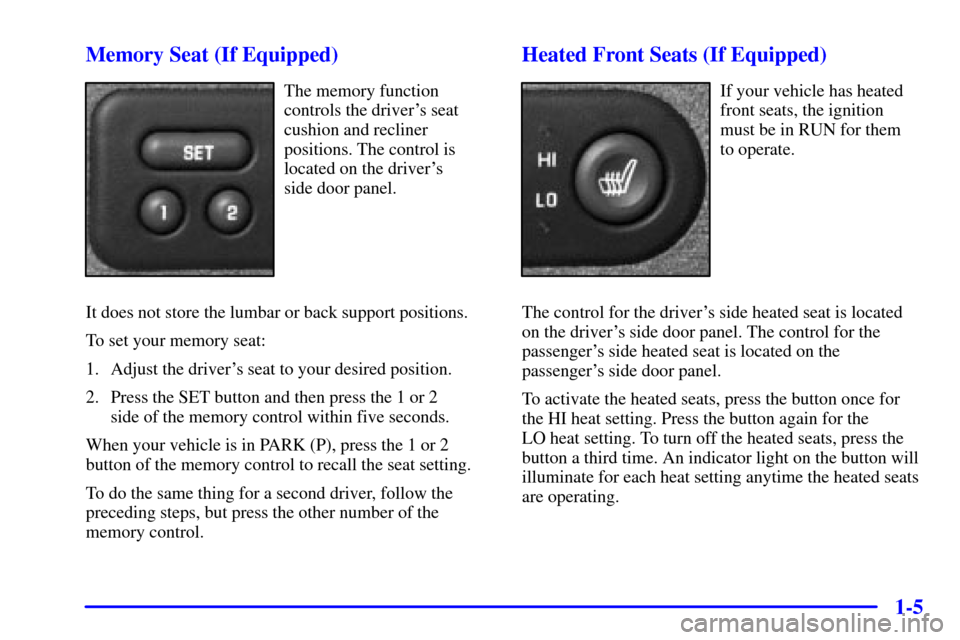
1-5 Memory Seat (If Equipped)
The memory function
controls the driver's seat
cushion and recliner
positions. The control is
located on the driver's
side door panel.
It does not store the lumbar or back support positions.
To set your memory seat:
1. Adjust the driver's seat to your desired position.
2. Press the SET button and then press the 1 or 2
side of the memory control within five seconds.
When your vehicle is in PARK (P), press the 1 or 2
button of the memory control to recall the seat setting.
To do the same thing for a second driver, follow the
preceding steps, but press the other number of the
memory control.
Heated Front Seats (If Equipped)
If your vehicle has heated
front seats, the ignition
must be in RUN for them
to operate.
The control for the driver's side heated seat is located
on the driver's side door panel. The control for the
passenger's side heated seat is located on the
passenger's side door panel.
To activate the heated seats, press the button once for
the HI heat setting. Press the button again for the
LO heat setting. To turn off the heated seats, press the
button a third time. An indicator light on the button will
illuminate for each heat setting anytime the heated seats
are operating.
Page 45 of 468
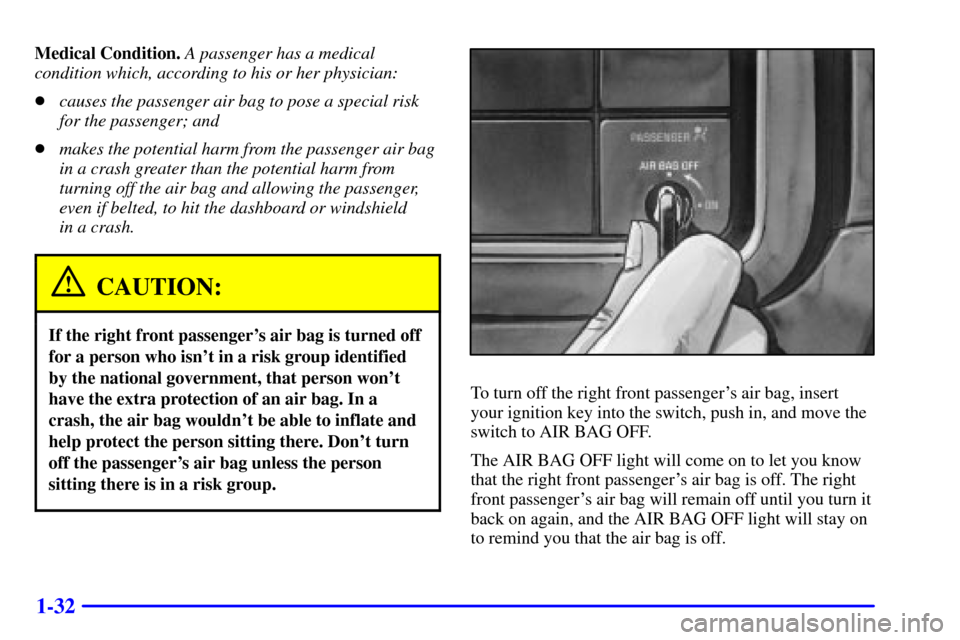
1-32
Medical Condition. A passenger has a medical
condition which, according to his or her physician:
�causes the passenger air bag to pose a special risk
for the passenger; and
�makes the potential harm from the passenger air bag
in a crash greater than the potential harm from
turning off the air bag and allowing the passenger,
even if belted, to hit the dashboard or windshield
in a crash.
CAUTION:
If the right front passenger's air bag is turned off
for a person who isn't in a risk group identified
by the national government, that person won't
have the extra protection of an air bag. In a
crash, the air bag wouldn't be able to inflate and
help protect the person sitting there. Don't turn
off the passenger's air bag unless the person
sitting there is in a risk group.
To turn off the right front passenger's air bag, insert
your ignition key into the switch, push in, and move the
switch to AIR BAG OFF.
The AIR BAG OFF light will come on to let you know
that the right front passenger's air bag is off. The right
front passenger's air bag will remain off until you turn it
back on again, and the AIR BAG OFF light will stay on
to remind you that the air bag is off.
Page 46 of 468
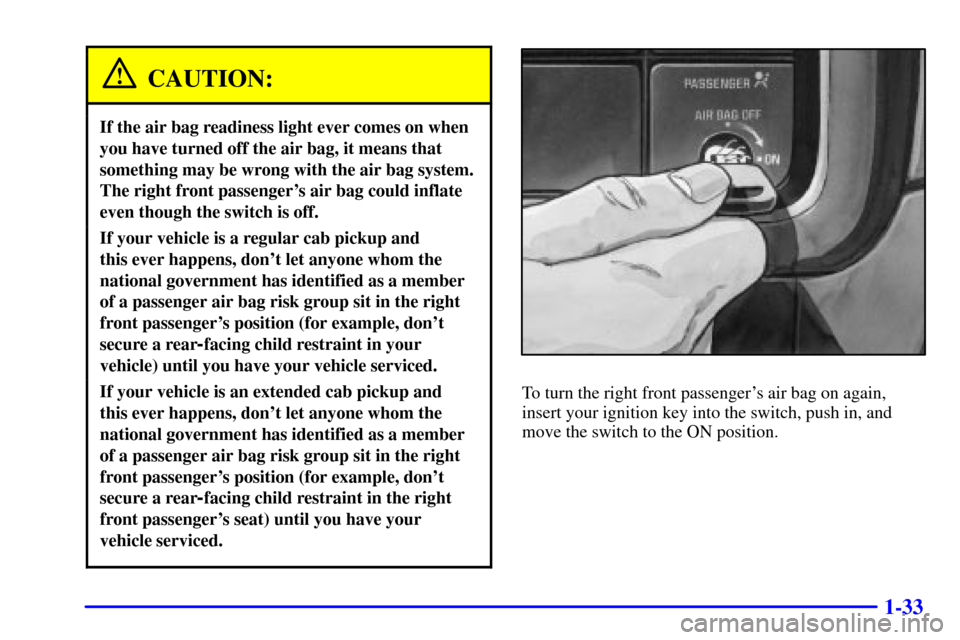
1-33
CAUTION:
If the air bag readiness light ever comes on when
you have turned off the air bag, it means that
something may be wrong with the air bag system.
The right front passenger's air bag could inflate
even though the switch is off.
If your vehicle is a regular cab pickup and
this ever happens, don't let anyone whom the
national government has identified as a member
of a passenger air bag risk group sit in the right
front passenger's position (for example, don't
secure a rear
-facing child restraint in your
vehicle) until you have your vehicle serviced.
If your vehicle is an extended cab pickup and
this ever happens, don't let anyone whom the
national government has identified as a member
of a passenger air bag risk group sit in the right
front passenger's position (for example, don't
secure a rear
-facing child restraint in the right
front passenger's seat) until you have your
vehicle serviced.
To turn the right front passenger's air bag on again,
insert your ignition key into the switch, push in, and
move the switch to the ON position.
Page 47 of 468

1-34 Servicing Your Air Bag-Equipped Vehicle
Air bags affect how your vehicle should be serviced.
There are parts of the air bag system in several places
around your vehicle. You don't want the system to
inflate while someone is working on your vehicle.
Your dealer and the service manual have information
about servicing your vehicle and the air bag system.
To purchase a service manual, see ªService and Owner
Publicationsº in the Index.
CAUTION:
For up to 10 minutes after the ignition key is
turned off and the battery is disconnected, an air
bag can still inflate during improper service. You
can be injured if you are close to an air bag when
it inflates. Avoid wires wrapped with yellow tape
or yellow connectors. They are probably part of
the air bag system. Be sure to follow proper
service procedures, and make sure the person
performing work for you is qualified to do so.
The air bag system does not need regular maintenance.
Adding Equipment to Your Air
Bag-Equipped Vehicle
Q:If I add a push bumper or a bicycle rack to
the front of my vehicle, will it keep the air bags
from working properly?
A:As long as the push bumper or bicycle rack is
attached to your vehicle so that the vehicle's basic
structure isn't changed, it's not likely to keep the
air bags from working properly in a crash.
Q:Is there anything I might add to the front of
the vehicle that could keep the air bags from
working properly?
A:Yes. If you add things that change your vehicle's
frame, bumper system, front end sheet metal or
height, they may keep the air bag system from
working properly. Also, the air bag system may not
work properly if you relocate any of the air bag
sensors. If you have any questions about this,
you should contact Customer Assistance before
you modify your vehicle. The phone numbers and
addresses for Customer Assistance are in Step Two of
the Customer Satisfaction Procedure in this manual.
See ªCustomer Satisfaction Procedureº in the Index.
Page 84 of 468

2-
2-1
Section 2 Features and Controls
Here you can learn about the many standard and optional features on your vehicle, and information on starting,
shifting and braking. Also explained are the instrument panel and the warning systems that tell you if everything is
working properly
-- and what to do if you have a problem.
2
-1 Windows
2-5 Keys
2-6 Door Locks
2-10 Keyless Entry System (If Equipped)
2-13 Rear Doors
2-14 Tailgate
2-15 Theft
2-16 Content Theft-Deterrent (If Equipped)
2-17 Passlock�
2-18 New Vehicle ªBreak-Inº
2-18 Ignition Positions
2-20 Starting Your Engine
2-23 Engine Coolant Heater (If Equipped)
2-24 Automatic Transmission Operation
2-28 Manual Transmission Operation
2-34 Four-Wheel Drive (If Equipped)
2-43 Parking Brake
2-44 Shifting Into PARK (P)
(Automatic Transmission Only)2
-46 Shifting Out of PARK (P)
(Automatic Transmission Only)
2
-47 Parking Your Vehicle
(Manual Transmission Models Only)
2
-47 Parking Over Things That Burn
2-48 Engine Exhaust
2-48 Running Your Engine While You're Parked
(Automatic Transmission)
2
-49 Manual Selectable Ride (If Equipped)
2-51 Locking Rear Axle
2-52 Turn Signal/Multifunction Lever
2-58 Exterior Lamps
2-61 Interior Lamps
2-63 Mirrors
2-76 OnStar� System (If Equipped)
2-80 The Instrument Panel - Your
Information System
2
-82 Instrument Panel Cluster
2-84 Warning Lights, Gages and Indicators
2-99 Message Center
Page 86 of 468
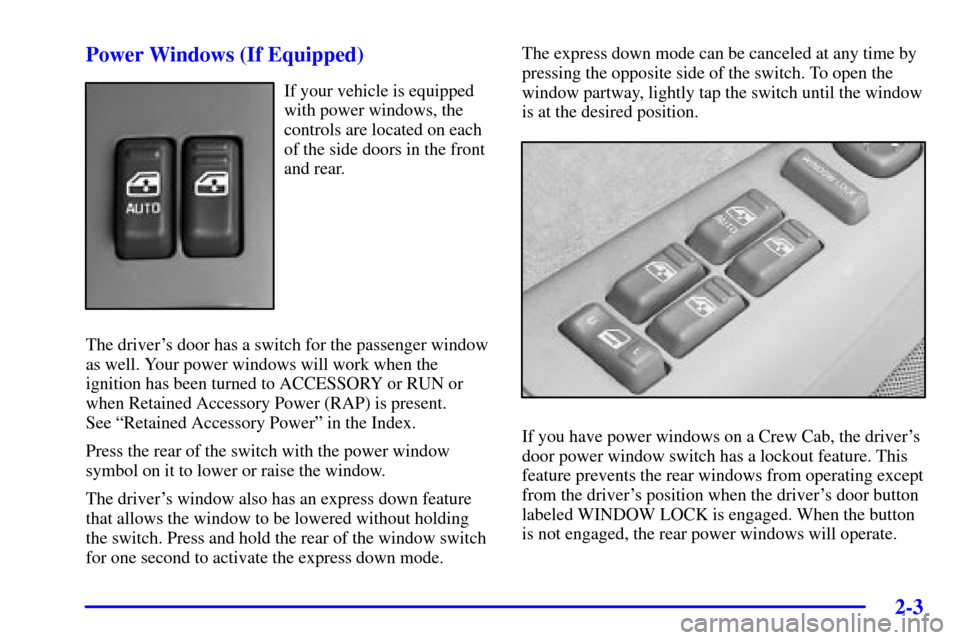
2-3
Power Windows (If Equipped)
If your vehicle is equipped
with power windows, the
controls are located on each
of the side doors in the front
and rear.
The driver's door has a switch for the passenger window
as well. Your power windows will work when the
ignition has been turned to ACCESSORY or RUN or
when Retained Accessory Power (RAP) is present.
See ªRetained Accessory Powerº in the Index.
Press the rear of the switch with the power window
symbol on it to lower or raise the window.
The driver's window also has an express down feature
that allows the window to be lowered without holding
the switch. Press and hold the rear of the window switch
for one second to activate the express down mode. The express down mode can be canceled at any time by
pressing the opposite side of the switch. To open the
window partway, lightly tap the switch until the window
is at the desired position.
If you have power windows on a Crew Cab, the driver's
door power window switch has a lockout feature. This
feature prevents the rear windows from operating except
from the driver's position when the driver's door button
labeled WINDOW LOCK is engaged. When the button
is not engaged, the rear power windows will operate.
Page 88 of 468
2-5
Keys
CAUTION:
Leaving children in a vehicle with the ignition
key is dangerous for many reasons. A child or
others could be badly injured or even killed.
They could operate the power windows or other
controls or even make the vehicle move. Don't
leave the keys in a vehicle with children.
Page 89 of 468
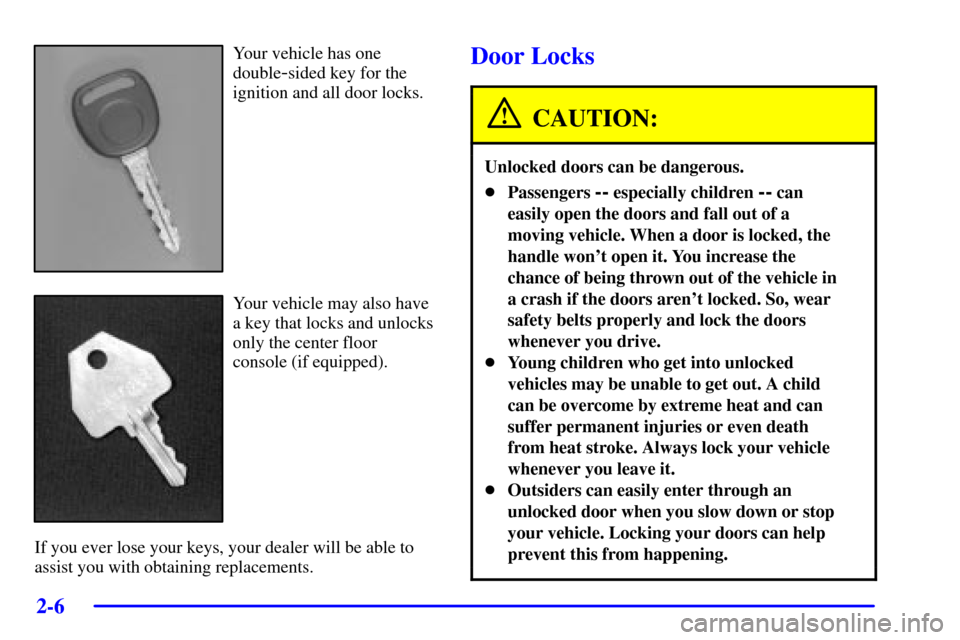
2-6
Your vehicle has one
double
-sided key for the
ignition and all door locks.
Your vehicle may also have
a key that locks and unlocks
only the center floor
console (if equipped).
If you ever lose your keys, your dealer will be able to
assist you with obtaining replacements.
Door Locks
CAUTION:
Unlocked doors can be dangerous.
�Passengers -- especially children -- can
easily open the doors and fall out of a
moving vehicle. When a door is locked, the
handle won't open it. You increase the
chance of being thrown out of the vehicle in
a crash if the doors aren't locked. So, wear
safety belts properly and lock the doors
whenever you drive.
�Young children who get into unlocked
vehicles may be unable to get out. A child
can be overcome by extreme heat and can
suffer permanent injuries or even death
from heat stroke. Always lock your vehicle
whenever you leave it.
�Outsiders can easily enter through an
unlocked door when you slow down or stop
your vehicle. Locking your doors can help
prevent this from happening.